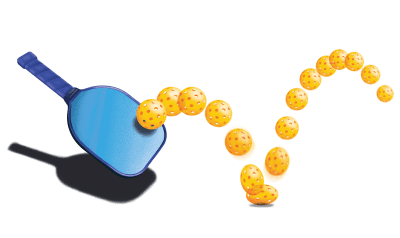No Matter What or Who You Are: The Enduring Cult of Rocky Horror
In the velvet darkness of The Waverly, Susan Sarandon clutches a single piece of newspaper, protecting her hair-sprayed coifs from the rain on the big screen. Her deliberately shrill Janet Weiss falsetto builds to a crescendo as an elementary school teacher named Louis Farese yells out, “Buy an umbrella, you cheap bitch.” Such was the beginning of Rocky Horror Picture Show’s so-called “counterpoint dialogue,” a tradition which would eventually become pre-recorded cassette tapes (and continue long after cassette tapes themselves were reduced to artifacts). Audience participation waxed into an art form, as shouting at the screen shifted into fully costumed, lip-synced performances, just as much a part of the midnight showings as the movie it shadowed. Long before Rocky unintentionally built itself into a tourist attraction, there was a performative scrambling to be a part of something bigger than the film. From that first jab at Janet, Rocky was becoming a cult.
Midnight showings of the movie were a weekly ritual in the late 1970s, and at the next show, the eventual president of the official Rocky Horror fan club, Sal Piro, remembers standing up with a giant joke ring during the wedding scene. He was unofficially the first Janet then, and officially when the first “shadow cast” came together for a rendition of the film a couple of weeks later at the Waverly (where the IFC Center now stands). It’s the stuff of legend at this point, though there’s no arguing those instances set off a chain reaction which laid the foundation for the now-decades-old Rocky community. The legacy of fandom sprawled out before them like a pair of hairy legs strapped hastily into fishnets. But in those catalyzing moments, they were just a couple of kids getting laughs on a pair of Saturday nights in the village.
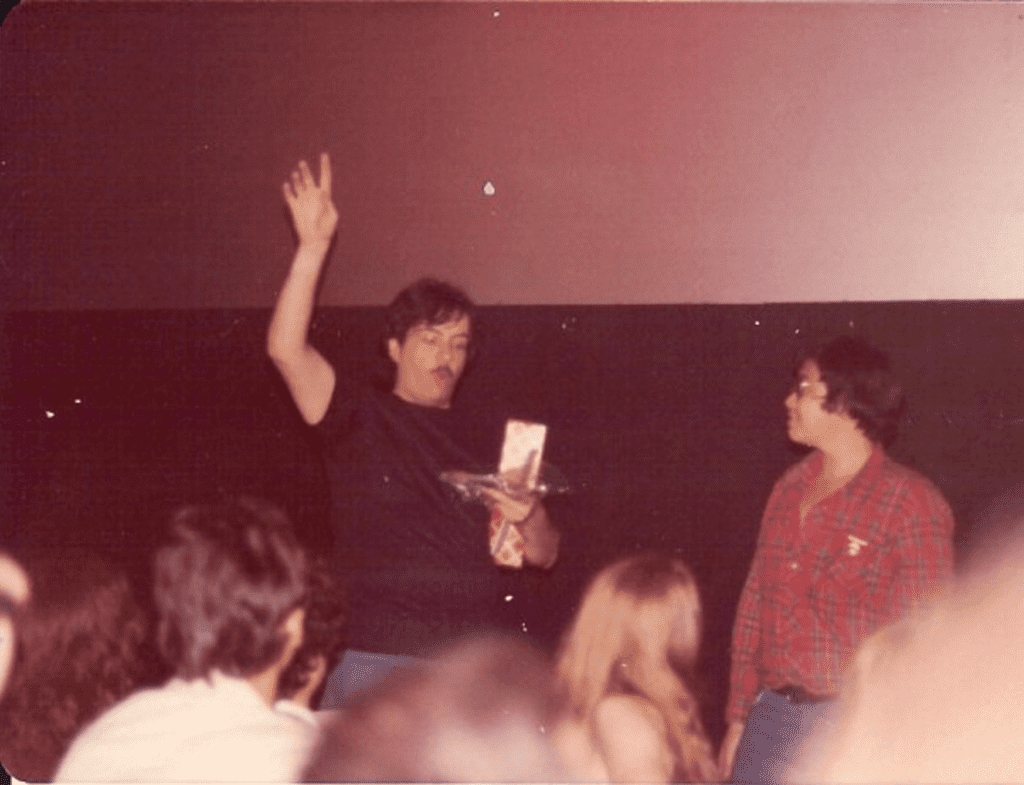 Sal Piro introducing an early performance (Courtesy of Lillias Piro)
Sal Piro introducing an early performance (Courtesy of Lillias Piro)
There’s something hyper-specific and localized about a Rocky shadow cast. Social media has allowed for a number of unexpected fandoms to prosper in 2016 (see: Bronies, Beliebers), but the Rocky community predated the internet, and has continued to require an increasingly rarefied in-person element long since its rise. Forty years after that initial shift into cult status, informal families are still thriving in the bellies of whatever movie theaters will have them. Casts from around the country, and even around the world. Rhode Island Frank N’ Furters, New Jersey Columbias, and UK Magentas stay in touch via Facebook or message boards, though the fandom is far more than a network of virtual communication culminating in a convention. It’s a lifestyle.
To track the continued endurance of Rocky fandom, we must go back to the beginning of its mutation into a branded community for the other. In the way of many camp classics, Rocky Horror was a flop when it first premiered in 1975. It got shelved after a quiet box office and lukewarm critical reviews, but was revived when its distributor, 20th Century Fox, threw it on the nighttime circuits in California, and soon several theaters in New York. There was an obvious draw for the LGBT community and theater kids, but also really anyone who felt left out of their assigned microcosms. Soon it was common to have seen the movie twelve or fourteen times, and shortly after that the shadow performances matured into the foundation for a band of outcasts, unquestioningly in love with one another, and pretty obsessed with Rocky Horror Picture Show, too.
The staying power of the film is evidenced by the new blood as much as continued involvement by the old guard. At an August performance in the Cinepolis theater in Chelsea (previously Bow Tie), a 48-year-old high school art teacher named Phil DeJean returned for a reprisal of his role as Eddie.
DeJean began performing when he was in high school, after the show moved to four blocks north to the 8th Street Playhouse in the early 80s. He hasn’t been a regular cast member for a few years now, but he doesn’t like to go too long without miming the leather-jacketed badassery of his on-screen surrogate. DeJean was a self-described quiet nerd growing up, and Meat Loaf’s renegade made him feel like he was emotionally bursting through a wall on a motorcycle. That feeling has yet to subside.
High school was hard for DeJean in the way it was for many Rocky lifers. “I wasn’t black enough for the black kids, I wasn’t Spanish enough for the Spanish kids,” he explained. “I was so left out growing up the Bronx before I found Rocky… It’s kind of like the island of misfit of toys. We don’t fit anywhere else, but we fit here.”
The show was about to start, and he surveyed the room as the audience filtered in. His stiff curls were long on his forehead, and they stuck up like pipe cleaners—a set of antennae probing the room.
DeJean leaned on the seat of a 22-year-old aspiring model and midwest transplant Tres Maxwell Wuerffel, who wore a “V” for “virgin” on his forehead, and a gold lamé bikini bottom he’d borrowed from a friend. He might have been embarrassed that he was going to have to fake an orgasm for the theater in a few minutes (as all first-timers are required to do), but perhaps found himself bolstered by his impossible cheekbones, and an aesthetic best described as “beatific twink.” The lights dimmed, and Wuerffel slumped down in his seat in a way that should have given him a paunch, but instead added two additional abs.
“They do a great job, but things have really been sanitized,” DeJean whispered, as the two hosts made their entrance. “There used to be pot smoke filling the air. There’s probably still sex, though.” A glimmer of Wuerffel’s bottom certainly suggested as much.
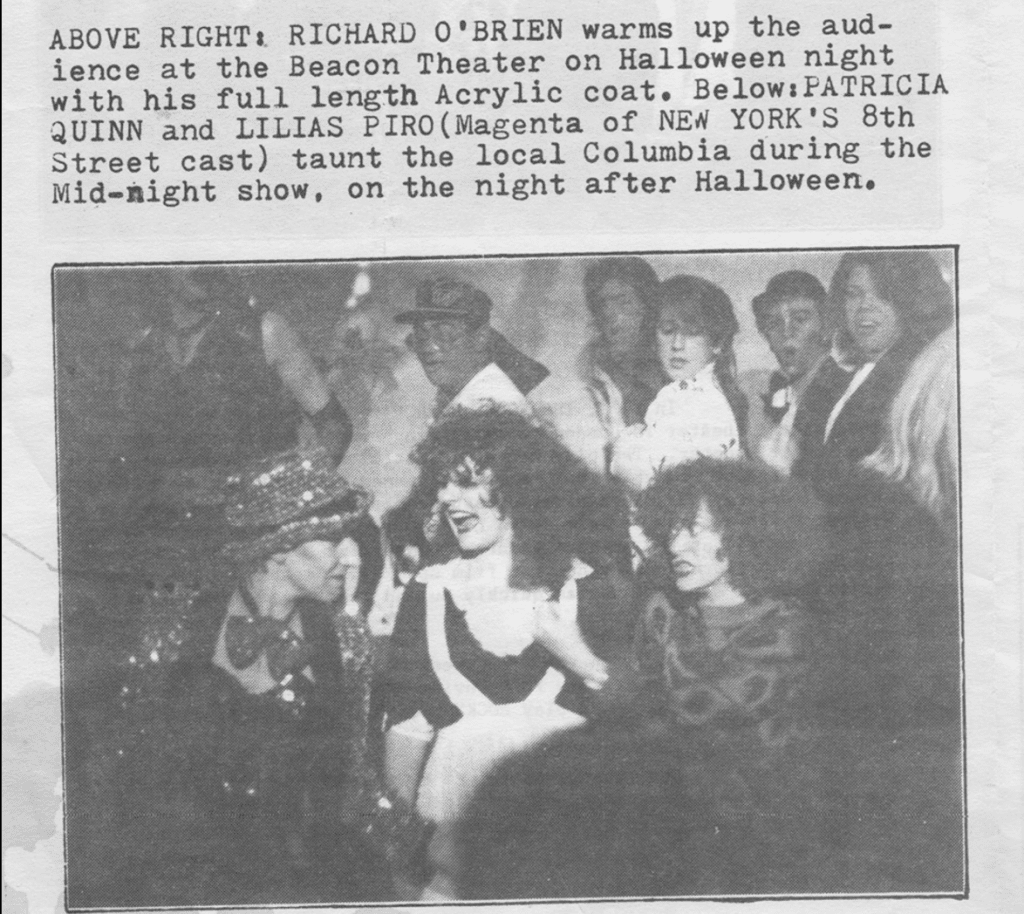

Of course, it wasn’t a big deal for him to be nearly naked. Pretty much everyone is nearly naked during the show, and that’s part of what’s so thrilling about it even now. Take for example recently graduated 23-year-old Rachel Guercio, who joined the Cinepolis group three years ago, but only started performing a few weeks back, when the cast’s co-directors and Brad and Janet left to get married and begin their life together. Now, she and her boyfriend, Eric Garment, 25, play Brad and Janet. Even a month ago, she could have never imagined herself stripped down at the the front of the house.
“I’ve definitely love to come performing a lot more now as I’ve gotten comfortable playing Janet,” Guercio said, her round face blushing as Janet’s might. “All of a sudden I was center stage in nothing, in a bra and underwear. I’ve come out of my shell entirely.”
Guercio saw the show early during her freshman year at St. John’s college. From that first night in Chelsea, she felt like she fit in, and she kept coming back until it only made sense to help out with the show. Or, actually, maybe “fit in” isn’t the quite the right way to put it.
“Not even just fitting into it, but them accepting me as who I am,” she explained. “Just coming in and being like ‘I’m Rachel, this is who I am,’ and them being like, ‘Hey Rachel, you’re awesome.’ That was the first time that had happened to me.”
There is a brightness in her voice. She’s self-aware of the vulnerable earnestness of her statement, and also totally comfortable with it. In a way, that only makes sense: these are her people. Guercio starting dating Garment when she started working tech three years ago, and they’ve been together ever since. Hooking up through Rocky isn’t rare. Heck, getting married through Rocky isn’t rare. (DeJean married his cast’s Columbia, though they’ve since divorced.)
“Most of my friend group comes from this or spins off of our main group,” Adam Jankas, a 25-year-old bartender at Schnipper’s in Times Square, told me over the phone.
Jankas was drawn to Rocky as a performer. He’s an actor, currently auditioning not quite as much as he’d like, who gets his theatrical fix from starring regularly as Riff Raff. He doesn’t love Rocky as much as he respects it, and enjoys exploring his identity through the lens of each character. By the time this piece goes live, he’ll have played all of them.
“Every character is very different, and you can find a part of yourself in it,” he said. “I find different parts of myself that I don’t get to express, and I let it out through that character. With Riff, I love to play the creep by making him horrendously overly sarcastic. I don’t get to do that so much in real life.”
Jankas was first exposed to Rocky in college at Middleton State University just south of Nashville, as was his best friend and the cast’s Magenta, Stephanie Mack, at Florida State. Both brought a love for shadow casting when they moved to New York after school, and it’s now very much the bedrock of their identities in the city. They’re passionate about delivering a quality show to their audience, giving the performances a crucial sense of dignity. Or, in other words, if you’re going to show up someplace twice a week at 11 p.m. for a hobby, the hobby better damn well feel like it matters.
“There’s no incentive other than you wanting to be there, so you have to put a little time in first,” Mack said of the audition process for adding on new cast members. “At first, we’ll put you on props or on lights, to show you’re committed, and not flaky.” Proving that you take things seriously is crucial to the emotional ecosystem of the Cinepolis cast.
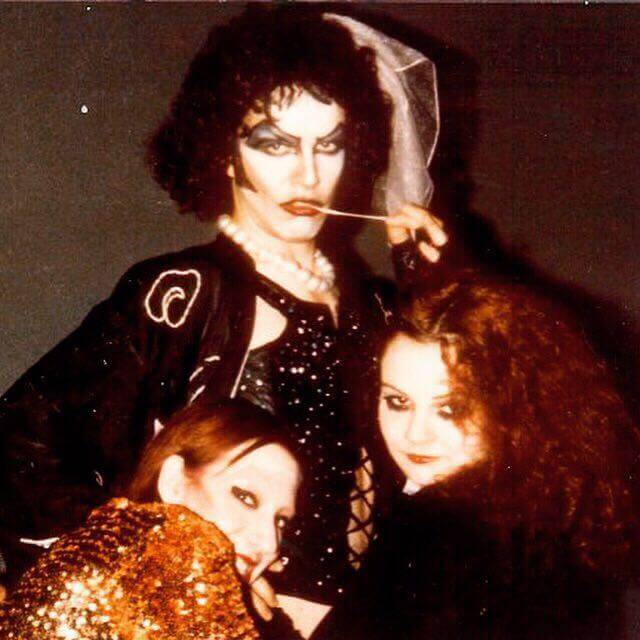

Courtesy of Lillias Piro
You don’t earn performance rights, so much as entry to the family system. Counterintuitive to the drama queen paradigm, there are people who only want to do props and lights. A 25-year-old woman named Megan Fierro got involved with Rocky in hopes of sticking to tech. Three years later, she’s played Frank-N-Furter—the lead and easily most demanding role—on several occasions, because they needed someone to fill the spot, and, well she’s there to do whatever she can to help out.
“It’s the job,” she told me while sitting on the floor of the theater, poking at a plate of cold takeout. “That’s what they needed me to do, so I did it.”
Fierro took the bar exam a few weeks back, but won’t hear back about results until the end of October. She has only the best memories about high school and college cast bonding experiences, and truly Rocky is a cast bonding experience that never ends. It’s been a solid foundation while she eases through a major transition period into a challenging career.
“I started just because I missed tech so bad, but with any show where you interact with the whole cast for an extended period of time you become each other’s family,” she said. “That happens with many casts, but the nice thing about Rocky is there’s no end date to it.”
Does she like performing, though? (She’s friendly when we talk, but also not making a ton of eye contact. This does not seem like the sort of person who would willingly strap into a corset for 140 minutes of erotic musicality.)
“It’s fine,” she replies with a shrug. “It’s so unlike who you get to be in the real world, and you really get to hone it, because there’s no expiration date.”
Fierro feeling that she has to perform as Frank is maybe the most telling detail about this wonderful group of people. There is a crucial sense of obligation upon which the entire system relies. They care about each other very much, but there’s an aura of professionalism that would disappear if the whole thing became just a group of friends casually hanging out. Dedication is the make-or-break element, which makes for a strict yet welcoming environment that insists upon self-importance. In order for the cult to survive this long, it had to learn to follow the rules.
The Rocky model is sustainable even in far smaller cities, where grow-your-own contingents pop up as shadows of the original shadow cast. There are performances throughout the country, though more often they are annual, most often around Halloween, biweekly, or monthly. Nowhere is held to quite the same rigor of New York. Different casts have different interpretations, though they all come together on the meta level of bonding over bonding over this magnificently absurd film.
Back in August, many of the casts met up for their annual convention. These year’s festivities were hosted in Rhode Island, and organized in large part by the local cast’s director Roy Rossi. For a time in the 80s and 90s, Piro was on payroll from the studio to run the fan club, responding to handwritten letters, and helping people in small towns to form casts. The “club” has been more informal for a while now, with various casts stepping up to host the con on a volunteer basis. Rossi got the job this time around, because he raised his hand when the time was right.
“It’s a very informal process,” said Rossi, 57, who started performing as Rocky during his sophomore year of college. “There’s no commissioner of Rocky Horror or something like that. I cannot compare this to any other convention. It’s more like a reunion.”

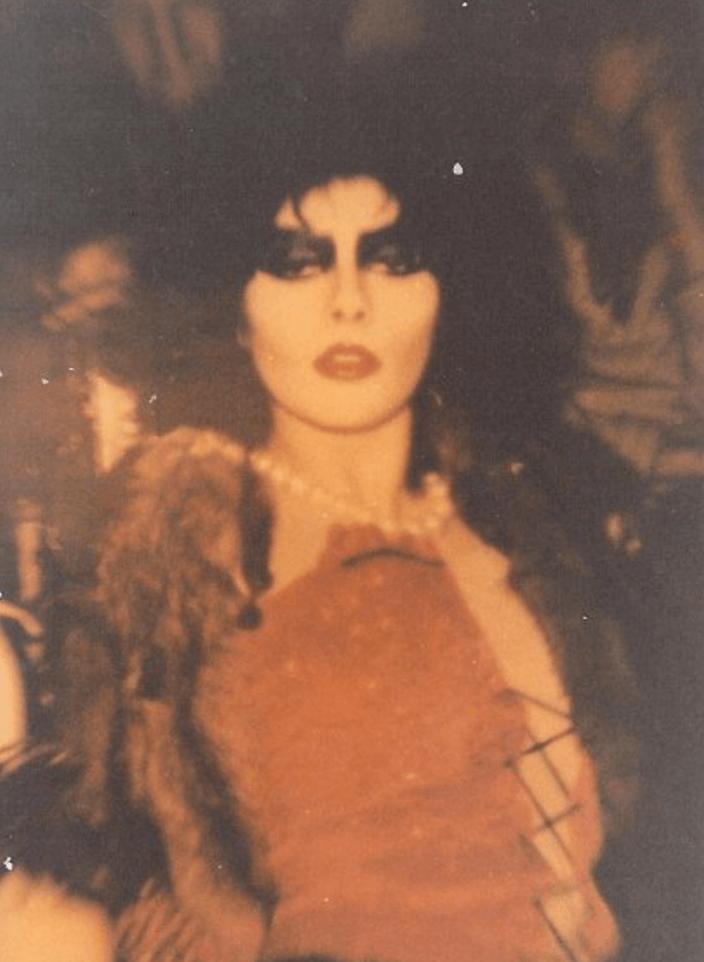

That might be the best way to picture things at the macro level: an extended network of immediate families, each with their own Columbia, Eddie, Brad and Janet. There’s a lot more versatility with the roles nowadays, though the way cast members are drawn to performing hasn’t changed, and there are echoes between DeJean’s New York experience and Rossi’s New England one.
“I was a loner, I had one friend, and he was going to Rocky, so I started going,” Rossi said. “I think a lot of us got involved because at some earlier point in life we may have not been connecting to the mainstream. I was socially maladjusted, but it’s more that we weren’t quite connecting with what has been given to us.”
“In this sort of thing, it’s a community,” he continued. “Other people have different things, they go to Church, and it’s not just worshipping God, it’s because they like being around other people who go to church.” And then: “I know that’s an extreme analogy.”
Over the course of our phone call, Rossi tells me about three too many times that he is straight. That’s not uncommon—most of the New York cast is as well—though there is certainly a stigma attached to Rocky, and probably the performing arts in general. There’s an obvious draw for even the straightest men, though, and that’s women in lingerie.
One performer, Larry Vizel, came for the sexiness in 1992 and stayed for the sense of community. Two and a half decades later, he’s married to the Columbia from his cast, with a four-year-old, two one-year-olds, and somehow enough energy left over to continue performing as Dr. Scott in Paramus, New Jersey. He hosted a recent iteration of the convention in New York, and helps Piro run the holdout infrastructure of the fan club. On a recent phone call, he explained different levels of Rocky dedication that form a sort of hierarchy of fandom.
It is possible to participate in a love for Rocky online. There are Tumblrs and whatnot, though that’s a different version of appreciation. Then, there are people who come regularly to see the show, often honing either a crass or witty version of the counterpoint dialogue. But at the core of it all, of course, are the shadow casts. Those hyper-local groups are what makes Rocky truly unique.
“We’re unlike any other fandom,” he told me matter-of-factly. “Think about it: There are annual Star Trek cons, but no local Star Trek fans, no regular Star Trek gatherings. We have our own individual communities built out of this.”
As Vizel sees it, Rocky began as a kind of “gathering of freaks,” but began to change shape once the film was released on DVD. With increased access, the doors opened a bit wider, allowing for groups to form in sparser areas like New Jersey or Rhode Island. When the film surges into the zeitgeist, as it did with Fame, Glee, and will again with the Fox reboot, a new crop of interest filters into their local Rocky theaters. The brand’s steady growth is bolstered by the preexisting effort. Each mainstream resurgence carts in potential new members without harming the preciousness of the film, because literally performing your fandom is a surefire way to transcend any purist suspicions of dilettantism. You simply can’t fake a corseted rendition of “Rose Tint My World.”
There has been a noticeable evolution, which has grown more formalized, while honoring the core tenets which fueled the cult’s formation to begin with. In the early days, Rocky fandom was an obvious haven for the gay community and its allies, especially given its Greenwich Village setting. The shadow cast climbed into French maid costumes and space suits while drive-by shootings and AIDS claimed the lives of some of their best friends. It’s certainly not “easy” to be gay now—will it ever be “easy” to be different?—but is easier than it was, and the shadow cast has become less explicitly escapist (see: less pot smoke in the air), and developed into an organized alternative social setting, which is more like an afterschool program than a secret society.
Still, the Rocky community of today was made possible through the conditions that informed its creation. Though the way things have shifted through the years makes for a different experience, it’s impossible to sever the current reality from its origin story, the anecdotes of which often rival the grandiosity of the film.
Sal’s sister Lillias Piro, 53, first played Magenta in 1978, and bore witness to all of the most iconic Rocky experiences. She was part of the group that once performed for Cher, Susan Sarandon, even Tim Curry himself, and that was hardly even a big deal at the time. “Everyone was coming to see us,” she said, easily justifying her cavalarity.

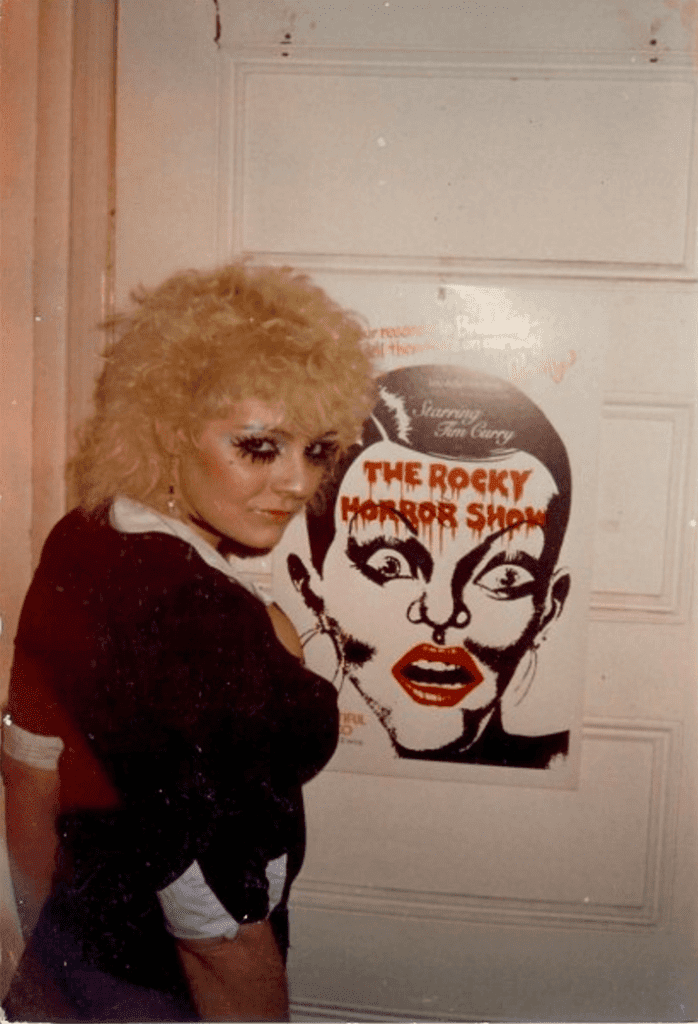

After the show relocated to 8th Street, a group of Japanese businessmen flew Lillias, Sal, and a couple other close friends to Japan to teach a local theater group how to perform the movie. She came of age in the exhilarating rush of cultural obsession with Rocky, which made for a life defined by the film, but far more important than the crazy stories are the people, many of whom remain some of her closest friends.
“I often think where would I be in my life without everything Sal built,” Piro told me on the phone. “He gave me all the love and attention anyone could ever want, that’s what he did for the people who were drawn to Rocky Horror.”
“Sal was really a gay rights activist,” she added. “He doesn’t think of himself that way, but I definitely do. Mostly, he just made so many people feel welcome.”
Piro performed for ten straight years as Magenta, and had crossover with DeJean. The two of them still come back sometimes, and keep in touch with the ever-shifting set of people who grew out of their original group.
“I keep telling Phil I can’t do this anymore,” she laughed. “I’m going to be in a wheelchair playing Magenta.” Piro knows she’ll keep coming back, if only sometimes, but Rocky will forever be part of her life, will have forever changed her, even if she never dons a curly red wig ever again.



“Long after the last chord is played, it’s the memories that you make,” she told me, her tone suddenly serious, wholly unconcerned by the cliché. “I don’t think you could ever walk away from Rocky without bringing a couple people with you. It’s about the people. That’s what it’s always been about.”
The current performances of the Cinepolis cast are a bit more tame, certainly not the kind of place where stories involving “Japanese businessmen” might be sewn, and yet the bond of the cast is as strong as ever.
To open the show, the cast warmed up the audience with semi-mandatory dancing. “Go crazy, it’s Saturday night!” Jankas commanded, prying the crowd from their seats in his role as host.
This is the weekly routine: Stale Top 40 hits like Ke$ha’s “Tik Tok” or Taylor Swift’s “Love Story” blast from the speakers, and what unfolds is something like the awkward corner of high school homecoming set to a “Now!” album from 2009. Tourists and a few groups of city kids eye each other nervously, before Jankas grabs a hold of Mack’s arm, pulling her into the center of the space. The two throw so much of themselves into gyrating along with the music, their energy pulls the room into orbit. They lose themselves in each other, and then—first in cliques, then as a group—the audience members follow suit. Shaking off the shackles of who they are and everything they worry about outside the doors of the theater, the crowd pulses into a place of total liberation, or something like it.
A gangly girl stands off the side, and DeJean taps her on the shoulder and throws himself into the dancing crowd. Soon she’s smiling, sliding off her self-awareness, and growing a bit more enthusiastic with each new movement. Almost everyone looks a little ridiculous, she seems to realize, and it doesn’t matter. This could be one great night, or, who knows? Maybe in a few months, she’ll be half-naked, serving face through a fine-tuned lipsync of “Touch-A, Touch-A, Touch Me.” A Rocky performance is a place where it’s impossible to make a fool of yourself. You can come for a night, or audition for a role, or build your whole life here, if you’d like. Wherever you may be struggling to find a place to fit in, the “Time Warp” is a mere dimension away.
You might also like 














